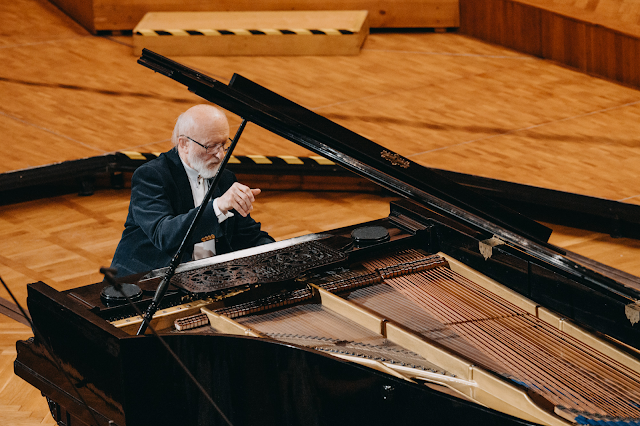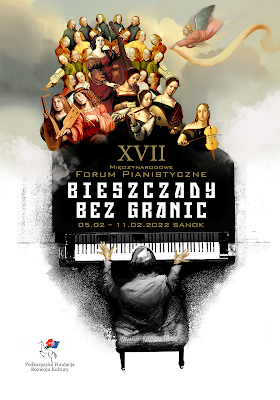Alexei Lubimov's magnificent recording of Brahms in 2024 on an ultra-rare Streicher instrument. Also my review of the truly extraordinary, transcendental Brahms recital on 28.08.23 at the Warsaw Philharmonic Concert Hall as part of the 'Chopin and His Europe Festival'. Lubimov played rare period pianos beloved by Brahms.
Rather than review in detail this profound, sublime, beautifully
recorded and designed CD, I refer you to my review below of his otherworldly recital of
the Brahms Intermezzi in Warsaw some eighteen months ago during the Chopin
and His Europe Festival.
It possesses the same deeply moving depths of emotion which I would not wish to belabour but only encourage you to listen and travel within the unseen worlds of Brahms music.
There are informative and clearly deeply felt observations in the accompanying notes by the National Polish Radio 2 presenter and musicologist Marcin Majchrowski. They elucidate in maturity the summation and reflections on life in the face of mortality, Brahms leading us finally to, yes, resignation.
 |
NIFCCD 154 |
Seven Fantasies op. 116 (1892) Capriccio. Presto energico
Johannes Brahms
Seven Fantasies Op. 116 (1892) Intermezzo. Andante
Johannes Brahms
Seven Fantasies, Op. 116 (1892) Capriccio. Allegro passionato
Johannes Brahms
Seven Fantasies Op. 116 (1892) Intermezzo. Adagio
Johannes Brahms
Seven Fantasies op. 116 (1892) Intermezzo. Andante con grazia ed
intimissimo sentimento
Johannes Brahms
Seven Fantasies Op. 116 (1892) Intermezzo. Andantino teneramente
Johannes Brahms
Seven Fantasies op. 116 (1892) Capriccio. Allegro agitato
Johannes Brahms
Two Rhapsodies Op. 79 (1879) Agitato
Johannes Brahms
Two Rhapsodies Op. 79 (1879) Molto passionato, ma non troppo allegro
Johannes Brahms
Three intermezzi op. 117 (1892) Andante moderato
Johannes Brahms
Three intermezzi op. 117 (1892) Andante non troppo e con molto
espressione
Johannes Brahms
Three intermezzi op. 117 (1892) Andante con moto
Johannes Brahms
Six pieces for piano op. 118 (1893) Intermezzo. Allegro non assai, ma
molto appassionato
Johannes Brahms
Six pieces for piano op. 118 (1893)Intermezzo. Andante teneramente
Johannes Brahms
Six pieces for piano op. 118 (1893) Ballade. Allegro energico
Johannes Brahms
Six Pieces for Piano, Op. 118 (1893) Intermezzo. Allegretto un poco
agitato
Johannes Brahms
Brahms, a fond owner of a Streicher piano
once said in his letter to the German pianist Clara Schumann that "There
[on my Streicher] I always know exactly what I write and why I write one way or
another”. He received one as a gift in 1870 and kept in his house until death
in 1897.
 |
| Piano from the J.B.Streicher's manufactory (Vienna, 1869) |
 |
| Alexei Lubimov |
Monday 28.08.23 at 20:00
Warsaw Philharmonic Concert Hall
Period piano recital
Alexei Lubimov
Johannes Brahms (1833-1897)
2 Rhapsodies, Op. 79 (1879)
Brahms wrote these passionate, agitated and attractive Rhapsodies in his maturity during his summer stay on the shores of the attractive Lake Wörthersee in Austria, Carinthia's largest lake.
 |
| Lake Worthersee, Velden, Austria |
The emotional impact from the very first notes was of mature musician and pianist who had lived and contemplated the interpretation of these pieces for his entire life. I felt them to be poetic and romantic presented by this older man who could call on the filter of a long struggle-filled experience.
Lubimov is a notable Russian dissident who has exhibited the greatest courage and tenacity in his resistance to absolutism. The landscape of subliminal musical resistance that lies beneath and is laid out for us is irreplaceable. A young pianist may imitate the emotional penetration of this evening's programme but cannot drive conspicuously to the creative and organic core of it. A strong polyphonic element was clear in the transparent structure of both which emerged as coherent wholes. This became increasingly obvious as the evening recital progressed to the Intermezzi.
A few words on the remarkable piano. Steinway innovations were copied by German and Austrian makers such as Friedrich Ehrbar (1827-1905) who manufactured the 1878 instrument we were listening to this evening. Ehrbar was a friend of Brahms and many of his symphonic works were first heard in two and four hand arrangements in his small concert hall in the capital. We were privileged indeed to hear these late works on this instrument.
Friedrich
Ehrbar took over the company in 1857 after the passing of Eduard Seuffert
[de] (1819-1855). In 1876 he created the Palais Ehrbar that possessed its own
concert hall in which renowned artists such as Johannes Brahms, Anton Bruckner
and Gustav Mahler performed. For the excellence of his products he was awarded
an imperial and royal warrant of appointment to the Emperor and King of
Austria-Hungary. He was also awarded a warrant of appointment to Archduke Otto,
imperial warrant of appointment to the Ottoman Sultan, a royal warrant of
appointment to the King of Greece, the King of Serbia, the King of Portugal,
and many others.
The balance of registers was particularly illuminating for the texture of these late Brahms works. The Steinway at the Paris exhibition of 1867 swept all before it and the piano as an instrument became immensely popular in Vienna in the 1870s. This was partly due industrial, commercial affordability and technological innovations such as overstringing and increased resonance.
According to the prescient English writer on music Malcolm MacDonald, in his book Brahms (p. 355 London 1990), the last four sets of Brahms piano music Opp. 116-119 'stand at the furthest possible remove from the rhetoric of the early sonatas or the pugnacious challenge of the large-scale variation sets. Though a few of them afford brief glimpses of the old fire and energy (Op.116 No.1 in D minor, marked Presto energico, contains virtuosity, fire and drama), the predominant character is reflective, musing, deeply introspective, and at the same time unfailingly exploratory of harmonic and textual effect, of rhythmic ambiguity, of structural elision and wayward fantasy.'
They have been known for their reflective nature, amalgamated with lyricism, desolation and heart-warming moments. The probable dedicatee of these works, Clara Schumann, with whom Brahms had a rather complicated relationship, praised them as 'a true source of enjoyment, everything, poetry, passion, rapture, intimacy, full of the most marvellous effects'.
7 Fantasies, Op. 116
Intermezzo in A minor Op. 118 No. 1
Intermezzo in A major Op. 118 No. 2
Ballade in G minor Op. 118 No. 3
Intermezzo in F minor Op. 118 No. 4
Romances in F major Op. 118 No. 5
Intermezzo in E-flat minor Op. 118 No. 6
The autumnal Brahms 6 Klavierstücke Op. 118 (1893) have always been close to my heart. In a letter to the conductor and composer Franz Lachner Brahms wrote (concerning the 1st Movement of the Second Symphony): 'I am, by and by, a severely melancholic person …black wings are constantly flapping above us'.
Dedicated to Clara Schumann, they were written at Bad Ischl during his summer sojourn and are probably his most well-known piano compositions nowadays. Julius August Philipp Spitta, a German musicologist, wrote to Brahms of these miniatures after receiving the score, 'They are the most varied of all your piano pieces and perhaps the richest in content and depth of meaning …'. Concentrated, intense and expressive, this group are a portrait of his internal emotional landscape.
These are among the last compositions by Brahms and he seems to have conceived them as a coherent whole. It is hard to overlook the presence of the spectre of death that inhabits them. The group speaks volumes to me of the transient nature of human existence, but more of a proud philosophical resignation to the inevitability of destiny than a sensationalist expression of terror, despair and melancholy in the face of our mysterious journey to oblivion.
The passionate outbursts of the first Intermezzo in A minor has such an affirmation of life in those rich chords, then the fading away and decay. These emotions were profoundly expressive with Lubimov. In the second sensitively played Intermezzo in A major, he savoured the desperate yearning and eloquent harmonic transitions of the Andante teneramente, the expressive dynamic variations and poetry, so lovingly embracing the long legato lines of transient affections. This ardent work has all the rhapsodic yearning and longing of a nocturne on the nature of mortality and lost love.
At this point in the recital I became uncannily aware that Lubimov the performer had actually dissolved, disappeared into the ether to become an unearthly, direct conduit for the music of Brahms now folding us in its embrace. Surely this process of rising beyond technique and even beyond the physical limitations of the instrument is a rarely a realized aspiration of any musician and the rarest experience for a listener.
Almost as a vengeful affirmation of life, yet hauntingly reflective, Lubimov exploded into the Ballade in G minor with its vigorous rhythms and a wonderful delineation of densely woven harmonies. He interpreted it as not merely a virtuoso piece for piano but a construction of monumental seriousness and substance.
In the contrapuntal texture of the fourth piece, the Intermezzo in F minor, Lubimov expressed the fluctuating, mercurial nature of emotional tension and calm waters, which seems inevitably followed by the etiolated nature of 'all passion spent'. The Chopinesque lullaby that inhabits the heart of the Romance in F major was movingly expressed, his touch and effulgent tone carried one away into rarefied realms. Variegated colors rose from the registers of this historic instrument, an extraordinary sound palette glowing before us.
The valedictory final piece is an extraordinarily forward-looking work that in many ways explores revolutionary melodic and harmonic boundaries of the day. This integrated meditation on the acceptance of destiny and fate, the Intermezzo in E-flat minor, begins with the theme of the Dies Irae of the Christian requiem. The spectre of death enters and recurs in the work in various guises. Here we begin to inhabit another world far beyond this one. A strenuous, heroic yet tragic averral of the force of life briefly emerges but the terminal expression of resignation in death concludes pianissimo. Lubimov, ego utterly extinguished, inhabited a world of a metaphysical medium in this scarcely bearable extinction of life.
3 Intermezzos op. 117
Intermezzo in E flat major Op. 117 No. 1
Intermezzo in B flat minor Op. 117 No. 2
Intermezzo in C sharp minor Op. 117 No. 3
 |
L. Rohbock / A. Fesca: View of Bad Ischl with the imperial villa in the foreground, steelplate engraving, 19th century
Copyright courtesy of Schloss Schönbrunn Kultur- und Betriebsges.m.b.H.
Lubimov passed without pause directly into Op.117. We began with the profound lyrical sadness of these Intermezzi, unsurpassed in the expression of profound sadness and dejection. This Op. 117 set of passionate musical denials and sacrifice was composed in 1892. They are intensely poetic and introspective works which Brahms thought of as 'three lullabies for my sorrows.' The first Intermezzo in E-flat major has a preface written on the score taken from an old Scottish ballad, Lady Anne Bothwell's Lament:
'Sleep softly, my child, sleep softly and deep!
How much it hurts to see you weep!'
The second in B-flat minor embraces a transcendental, almost metaphysical mood with its flowing line. The third in C-sharp minor is thought to be inspired by Gottfried von Herder’s poetic lines 'Oh woe! Oh woe, deep in the valley…' with its rather angular yet mysteriously rich atmosphere. When Brahms unsurprisingly sent this set of Intermezzi to Clara Schumann, she wrote 'In these pieces I at last feel musical life stir once again in my soul.
Lubimov adopted a reflective, soft tone and tender touch with a great deal of poetic sensibility for these regretful masterpieces. They speak directly to the heart of the turbulent emotions of unrequited love and romantic loss.
His phrasing, tempo, dynamics were all profoundly expressive and again I felt Brahms was communicating directly in musical speech with my soul. The breaths Lubimov took were at once moving and deeply affecting in sensibility. Regrets were recalled, those griefs that cannot be reversed. He carried us onto different emotional layers and into shifting moods ranging from remorse to anger to resignation. The nostalgic remembrance of past joys and dark thoughts was close to unbearable in this conduit, this direct communication with the composer.
Fryderyk Chopin (1810-1849)
Barcarolle F sharp major Op.60 (1846)
 |
Venice from the Lagoon 1840 Joseph Mallord William Turner 1775-1851 The Fitzwilliam Museum, Cambridge |
Finally the Chopin Barcarolle. His restrained and deeply poetic approach to this work made it an inarguable choice to follow the Brahms. A perfect opening that painted the prevailing atmospheric mood in a watercolor wash of the lagoon. It was an ardent love song to a romantic dream voyage from the outset, as if sailing into a late Turner watercolour of Venice.
The work is a charming gondolier’s folk song sung to the swish of oars on the historic Venetian lagoon or a romantic canal, often concerning the travails of love, a true song of love and reflective waves of thought. The emotions fluctuate as they do in the heart of any heart containing sensibility, grace, emotion and taste. Lubimov never succumbed to the temptation of overblown temperament and atmosphere. We are sailing on a pool of enchanted water and not weathering the storm tossed Atlantic.
It is a grand, expansive work from the late period of Chopin, written in the years 1845–1846 and published in 1846. Chopin refers in this work to the convention of the barcarola – a song of the Venetian gondoliers which inspired many outstanding composers of the nineteenth century, including Mendelssohn, Liszt and Fauré. Yet surely his barcarolle is incomparable…
As with the Berceuse, Op. 57, the work may be considered ‘music of the evening and the night’ (Tomaszewski). However, it is a far longer work and of immense difficulty. The work is not only a contemplative nocturne although there are similarities – it explores the many passions of lovers that erupt and sleep during the day and the night. The penumbra of eroticism, Venice and the atmosphere of Mediterranean passion present in the ornamentation is strongly present in this masterpiece with its universal heartfelt emotions.
The most musical, evocative and perfect emotional portrait of love contained in the Barcarolle I have ever heard from any pianist at any time.
Encores:
Mozart Fantasy in D minor K. 397 This was an extraordinary interpretation that I found profoundly moving in its innocent simplicity
Schubert Intermezzo in E flat major Op. 90 No.2 D. 899 A magical performance that surprised everyone
Silvestrov Lullaby An appropriate choice of Ukrainian composer
Also never forget the period Pleyel pianino of Chopin in another intimate and musically transporting recording by
Alexei Lubimov
http://www.michael-moran.com/2020/10/the-pleyel-pianino-of-chopin-in.html











Comments
Post a Comment